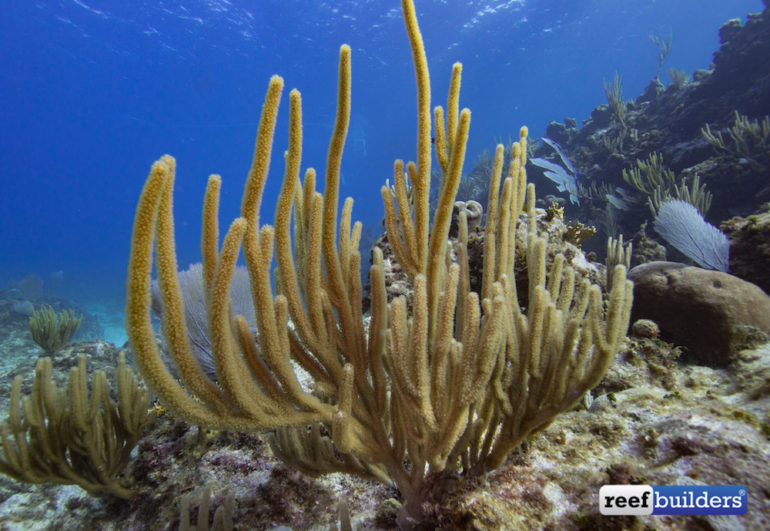In our previous installment of this series, we met with a diverse array of Soft Corals and Gorgonians, including most of the species familiar to aquarists. Amongst these were a hodgepodge of ex-Scleraxonia, ex-Stolonifera, and ex-Alcyonacea genera, now all lumped together as a messy shrubbery of clades within the newly recognized order Malacalcyonacea. Before we leave this group, there is still one more major lineage to explore, composed of species that had previously formed the bulk of the Holaxonia Gorgonians, but also with a few unexpected surprises thrown in for good measure.
Recall that the former order Holaxonia was diagnosed by the composition of its axial skeleton, being made up of a protein called gorgonin that is frequently impregnated with varying forms of calcium carbonate—this is in contrast to the fused sclerites of the Scleraxonia or the crystalline calcite or aragonite of the Calcaxonia. For the most part, Holaxonia has proven to be more or less phylogenetically correct, albeit with a few minor (but interesting) exceptions.
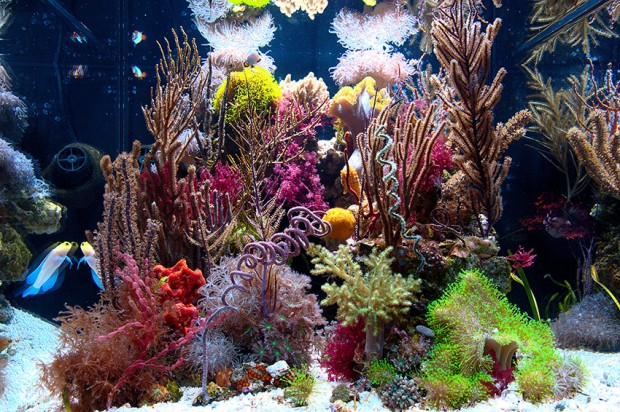
The most notable of these outliers is Dendrobrachia, a small genus of delicate deepsea Gorgonians that lacks sclerites; we’ll encounter it again in our upcoming exploration of the Scleralcyonacea. Also in that order (but not closely related) is Ideogorgia, an obscure genus from South Africa and Argentina whose affinities have long been unsettled, owing to a peculiar sheath of sclerites that surrounds its gorgonin skeleton. Lastly, within Malacalcyonacea there is Acanthoaxis, described in 2010 from Cameroon; its colonies lack sclerites and can either be encrusting or erect thanks to the variable presence of a hollow, cross-chambered skeleton covered with small spines.
Thus we have a minimum of 4 separate instances where the production of gorgonin has appeared within Octocorallia. But why is this? What factors might have favored its development in these disparate groups separated by several hundred million years of evolution. Or is it possible that gorgonin was present in the ancestor of all modern octocorals and then subsequently lost throughout? And are these gorgonin skeletons even chemically homologous, or might there be subtle differences that have gone unnoticed?
The family-level classification of Holaxonia was always a bit sketchy and put a great deal of emphasis on the appearance of the axial skeleton’s hollow core. But this trait was often ambiguous and genera could convincingly be shuffled about seemingly at the whim of the taxonomist. Molecular data now indicates that the sclerites provide a far more useful diagnostic tool, and this is supported further when comparing their biogeography. So let’s get to know these dozen gorgonian families.
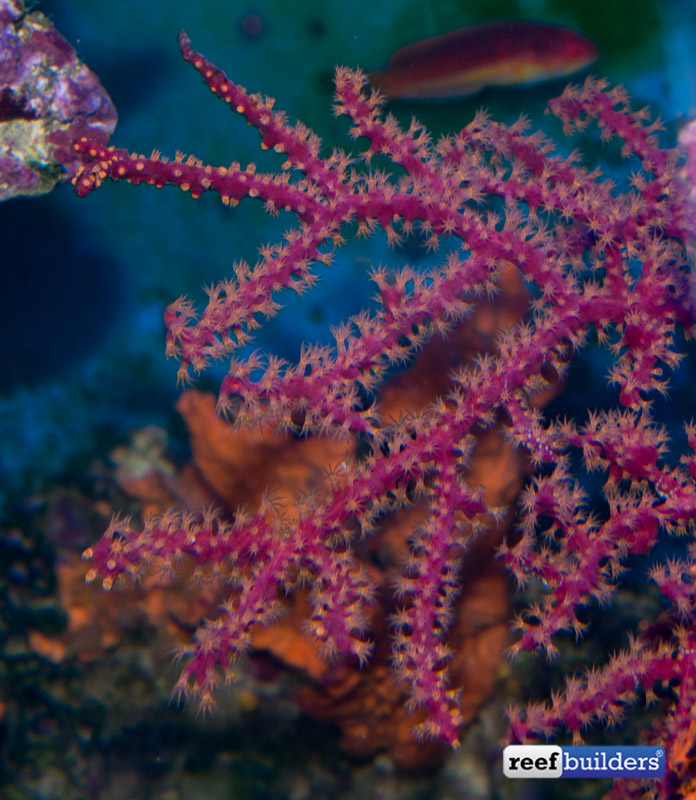
Plexauridae & Pterogorgiidae
In older classifications, Plexauridae was the most diverse of the holaxonian families and encompassed a broad geographic and ecological range, but it is now mostly limited to the tropical West Atlantic, plus Muricea in the Eastern Pacific. Several of these genera (Plexaura, Pseudoplexaura, Eunicea) are zooxanthellate and periodically available to aquarists.
Pterogorgiidae is a new family with several genera in the tropical West Atlantic, plus the small (monotypic?) genus Pinnigorgia in the West Pacific—this disjunct distribution is generally uncommon amongst octocorals, but we’ll see it again in Gorgoniidae. Pinnigorgia is often maricultured, and some of its relatives in the Atlantic (Pterogorgia, Muriceopsis) have also been available, as these are all zooxanthellate (though the family also includes azooxanthellate species). The plexaurids and pterogorgiids are closely related and form a basal clade relative to the other families we’ll be discussing here, but neither is easily defined in terms of morphology.
Eunicellidae, Scleracidae, Plexaruellidae & Gorgoniidae
These families are all somewhat closely related and predominantly found in the Atlantic. Scleracis is a deepwater Caribbean genus with large surface sclerites; Plexaurella is a zooxanthellate Caribbean genus, occasionally available to aquarists, best recognized by having sparsely branched colonies and polyps that retract into slit-like apertures—these were formerly confused with the plexaurids, but differ in having a heavily calcified axial skeleton and “butterfly sclerites”.
Gorgoniidae is a widespread group and is probably the most familiar. The fan-shaped species of Gorgonia and its feathery counterparts in Antillogorgia are both ubiquitous in the Caribbean, the latter often being available to aquarists. But the family also includes a couple bizarrely flattened genera, Brazil’s Phyllogorgia and Chile’s Phycogorgia, plus there’s a single Indo-Pacific genus, Pseudopterogorgia. The family is loosely defined by having relatively small surface sclerites and inclusions of carbonate hydroxylapatite in the axial skeleton.
Lastly, the eunicellids are an oddly schizophrenic group. On the one hand, there’s Eunicella, a common genus of Gorgonians in the Eastern Atlantic diagnosed by its distinctive “balloon-club sclerites”; on the other hand, there’s Complexum, an obscure tropical Western African genus of azooxanthellate Soft Corals. These seem like odd bedfellows, but the molecular data is unequivocal in supporting a close relationship for these genera, which goes to show just how malleable bodyplans can be in Octocorallia.
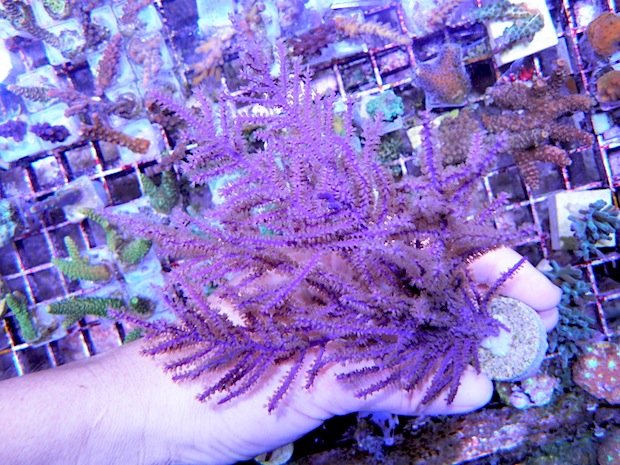
Paramuriceidae, Astrogorgiidae, Euplexauridae, & Anthogorgiidae
These families are all somewhat closely related and predominantly found in the Indo-Pacific, though Anthogorgiidae actually derives from amongst the Atlantic families that were just discussed. Anthogorgia caerulea is a common aquarium export known as the Blueberry Gorgonian (often misnamed as Acalycigorgia) on account of its vibrant polyps, though it seldom thrives in captivity. Also in this family is Muricella plectana, a large fan-shaped species home to Bargibant’s Pygmy Seahorse. The group is defined in part by having abundant sclerites in their polyps, such that they are unable to be withdrawn into the surrounding coenenchyme.
The same can be said for the spiny polyps of Acanthogorgia, which is now included within the newly recognized Paramuriceidae. This family was split from its Atlantic counterparts, Plexauridae, and now accounts for the most diverse group of Gorgonians in the Indo-Pacific. Here we find just about every colony shape and size imaginable, from fans to bushes to sparse twigs or wires, usually with retractile polyps, but sometimes not. Remarkably, there’s also a small, cushion-like Soft Coral from the West Coast, Thrombophyton. One important morphological trait shared by most of these is the presence of “thornscale sclerites”, as well as the development of “collaret & points sclerites” in the polyps.
Astrogorgia has long been associated with the paramuriceid genera, but it notably lacks thornscales and tends to have somewhat flattened branches. Euplexaura superficially resembles some of the Atlantic plexaurids in having a greatly thickened coenenchyme, but these azooxanthellate Gorgonians instead form a small sister group to the paramuriceids, though the absence of thornscales helps to distinguish these.
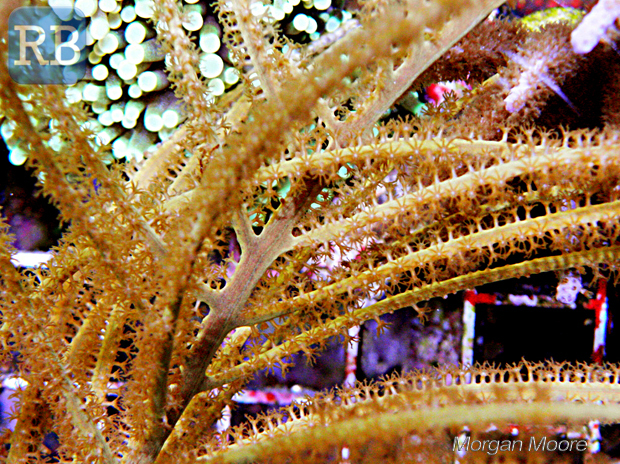
Isididae
Most Indo-Pacific Gorgonians are azooxanthellate, which explains why so few of them are ever seen by aquarists, but Isididae is a major exception. This family has undergone a dramatic shift, as it formerly included a broad array of deepsea Bamboo Corals, now recognized as belonging to the Scleralcyonacea. All that remains of its original configuration is Isis hippuris, a West Pacific species with a peculiarly jointed skeleton of gorgonin nodes and calcareous internodes. But rather than the crystalline internodes seen in a true Bamboo Coral, Isis has bundles of calcite that appear to derive from highly modified sclerites. It’s now also joined by the Indo-Pacific genera Rumphella and Hicksonella, both of which possess a more typical gorgonin axial skeleton, but all three otherwise share similarities in their colony shape and sclerite morphology, hinting at their unexpectedly close relationship. Rumphella aggregata is sometimes available to aquarists.
Keroeididae
This small family has always been a bit of an enigma. The axial skeleton is mostly gorgonin, but with an outer layer of sclerites, thus combining aspects of the old Holaxonia and Scleraxonia. These tend to be uncommon and restricted to moderate depths, and few have been investigated with molecular data. Of those that have, the aforementioned Ideogorgia has been relocated to the Scleralcyonacea, while the type genus Keroeides remains as an isolated lineage nestled amongst the Gorgonian families that we’ve been discussing. Thelogorgia and Pseudothelogorgia may also belong here (or they may not); these are equally obscure groups, the latter sometimes occurring on coral reefs of the Indo-Pacific.
Taiaroidae
Oddly enough, the alleged sister group of Keroeididae is Taiaroa tauhou, the gargantuan solitary species from Indo-Pacific deepsea habitats formerly classified as a protoalcyonarian. On the surface, this makes zero sense, but dig a little deeper and this still doesn’t make any sense. These are, of course, lineages that are separated by hundreds of millions of years of evolution, and a lot can happen over such a long timeframe. It would have to be assumed that the ancestors of Taiaroa were at some point more Gorgonian-like, but, much like in Complexum and Thrombophytum, decided to explore a different morphological path. The remaining protoalcyonarian genera are still too poorly known to hypothesize about, but it seems unlikely that any of these are closely related.
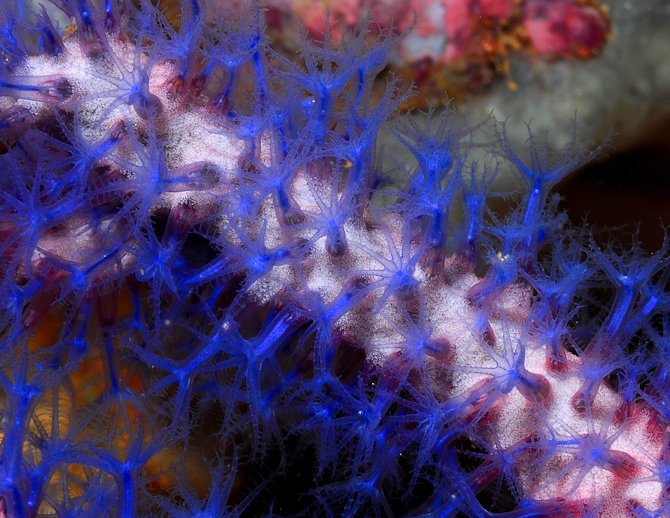
Discophytidae
Lastly, a brief mention to Discophyton rudyi, the odd little encrusting species from the West Coast that, like Taiaroa and Complexum and Thrombophyton, appears to represent a Gorgonian that has lost its way. No doubt there will be many more of these discovered once molecular data is brought to bear on all of the poorly studied octocorals out there. One possible example that jumps to mind is New Caledonia’s gorgeous purple mystery coral.
And with that, we’ve at long last reached the end of the Malacalcyoncea (well, aside from all the small families that we’ve shamelessly ignored along the way). Next up will be its charismatic sister lineage, Scleralcyonacea, a group chock full of morphological oddities, stretching Octocorallia to its very limits.
About the author
Joe Rowlett is the author of Indo-Pacific Corals and studies marine biogeography and speciation. He is a former aquarist and has written extensively for aquarium publications.


